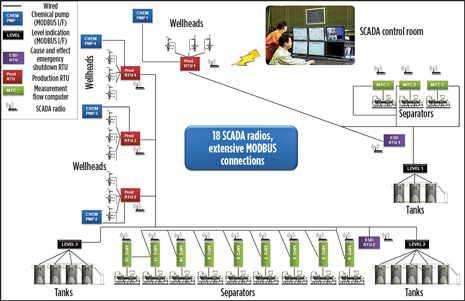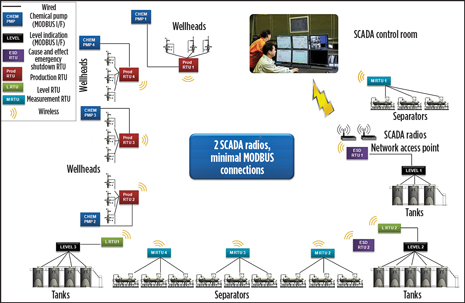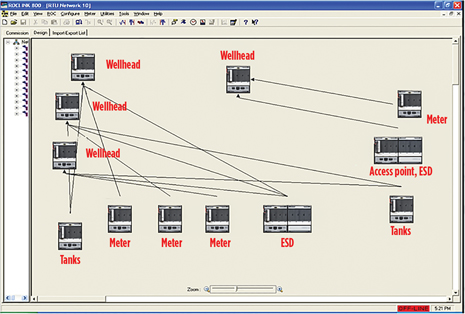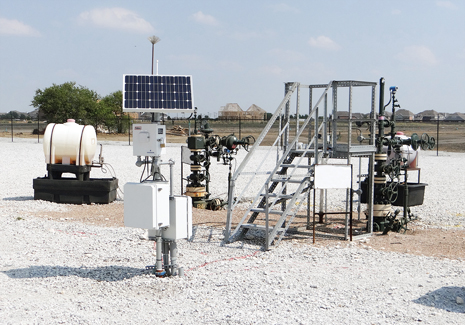Distributed automation streamlines operations on multi-well pads
Reduced drilling costs, combined with a smaller environmental footprint, have driven the burgeoning growth of multi-well pads.
Two groups had a need to access data from the sites: production and measurement. The production organization had one set of electronics, to monitor tank levels and to execute plunger lift control algorithms. For monitoring gas production, the measurement group had a separate set. Both electronic implementations were based upon Emerson’s FloBoss family of Remote Terminal Units (RTUs), but configured to serve specific purposes. On the production side, RTUs are configured using Production Manager, a software package provided by Vinson Process Controls. To operate a plunger cycle, the user interface permits selection of various triggers, several of which are based upon data acquired from a measurement RTU. In one case, high pressure resulting from the initial rush of gas production, when a sales valve is opened, can exceed the range of flow transmitters. When such flow is not accurately accounted for, gas production is effectively lost for a short period of time, many times each day. Triggers can be used to throttle back the flow, via an electronically actuated valve, to prevent such loss of measurement data. A second approach controls the duration of the plunger lift after-flow cycle, based upon current flowrates. Oftentimes, critical velocity calculation is involved. Critical velocity, as determined by well-known Turner and Coleman equations, is the minimum flow required, from the well, to lift liquids. Flow below this value will cause liquid to collect in the well, eventually curtailing production. By receiving updates concerning each well’s flowrate, after-flow can be terminated at the point that most optimizes overall gas production. In all trigger cases, it is imperative to receive timely updates about each well’s flowrate from their respective measurement RTUs. Additionally, individual tank levels are continually monitored to execute related well shutdowns, using a cause-and-effect program. From the measurement view, adherence to American Petroleum Institue (API) and American Gas Association (AGA) standards—for flow computation and audit trail requirements—was of paramount concern. RTUs configured to act as traditional flow computers fulfill these needs. Overall, each pad was tied back to a main corporate office, via several long-haul radios. Production activities, including plunger-lift optimization, would then be reviewed by personnel in the main office. Measurement data would be made available, as required by accounting. PAD DATA MANAGEMENT PROBLEMSThe classical approach, based upon common automation practices, is depicted in Fig. 1. Essentially, the two groups—production and measurement—had separate systems that exchanged limited data, using a hardwired, multi-dropped MODBUS communication protocol interface. This approach suffered from several drawbacks that proved difficult, if not outright impossible, to overcome on wellsite installations.
Electrical properties, associated with lengthy cable runs, caused complications. Inconsistent data update times—ranging from 1 to 15 sec—led to troublesome control-loop execution. With so many items in play—including separator pressures, gas level detectors, flow measurements, tank levels, acoustic detectors, as well as chemical pumps—the process of mapping MODBUS registers proved time-consuming and difficult to manage. The system was brusquely described as a nightmare of MODBUS mapping and convoluted wiring. Furthermore, normal field planning often requires the drilling of a small number of wells, with the intent of adding additional wellbores at a later date. This approach led to dilemmas with the deployment of the automation systems. Classical methods needed advance notice to plan for the larger number of device point counts. Or each new well installation became a brownfield upgrade, incurring all the inherent expenses associated with increased on-site labor and deferred production. Headaches only increased with the expanded drilling programs underway. WIRELESS DISTRIBUTED LOGICTo address these weaknesses, XTO performed a pilot test, based upon Emerson’s concept of a Distributed RTU Network (DRN). A DRN is a time division, multiple-access (TDMA) based, time-synced, “master-less” wireless RTU network. It is peer-to-peer addressable and requires no MODBUS protocol register mapping. The pilot wellsite was modified from the classical approach, as depicted in Fig. 1, to the DRN version shown in Fig. 2.
The RTUs are the same type of equipment as used in the classic approach. Additional hardware is added to each unit in the form of a short-haul radio module. Operating in the 2.4-GHz frequency band, the technique is basically the same as is commonly found in Wi-Fi applications. Distances of up to 10 mi (line of sight) can be crossed, which readily covers the area of a well pad and allows for access to remote sites. While the RTUs are of the same family, the units can be composed to fit a particular functionality. In the case of the pilot, units were outfitted to operate three plunger-lift wells, each. Other units handled the measurement requirements, at multiple meter runs, and yet another style performed tank-level monitoring and executed surface shutdown control logic. Each of these RTUs became a node on a network. Instead of using MODBUS registers to map data between RTUs, the distributed system makes use of a drag-and-drop technique in its design mode, Fig. 3. A user adds an RTU to the network, and then proceeds to select points to either send to, or receive from, other network RTUs. This means that an RTU’s database is “browsable” by other RTUs in the network.
ROBUST COMMUNICATIONSA network can support up to 25 RTUs or nodes. The pilot program required 12 such devices. Should the network configuration grow to exceed the maximum limitation, a second network can be created. To avoid conflict between multiple networks, utilizing the same radio frequency spectrum, communications are based upon selectable pre-determined “hop patterns.” Up to 15 networks can co-exist. One of the nodes serves as an access point for the network. This node can discover other nodes automatically, as they are added. A user has the ability to select which nodes become part of a particular network. The access point also serves as the central location for a SCADA application. That is, only one long-haul radio is needed to connect to a distant SCADA host server. The rest of the nodes can all be accessed directly, via the host, by making use of a “pass-through” feature of the network protocol. For the pilot test, two long-haul radios were kept in service, to avoid modifications to the SCADA server. In the current configuration, an RTU dedicated to handling tanks and emergency shutdown logic was designated as the access point. The unit would process selected information from other network nodes, and issue appropriate shutdown commands. The update time, for all of the devices on the network, is 1 sec, which is suitable for critical control requirements. The ability of the RTU to monitor the wireless link between remote nodes provides a mechanism to ensure that the system is fail-safe. Programming can be customized to take specific actions on one or more units, in the wireless network, should communications be interrupted. FIELD RESULTSFrom the beginning, the pilot’s purpose was not to modify current operations; the pilot equipment performed the same function as the preceding classical implementation. Rather, the intent was to demonstrate enhancements for future well installations. The results exceeded expectations. Benefits projected in the next installations include several items detailed below. Elimination of cabling, heavy-equipment trenching. Wireless technology eliminates the need to trench and bury conduit between the wellhead equipment, and the separators and storage tanks. Previously, end-device, emergency-shutdown signals and MODBUS communications wiring had to be routed through these underground pathways. Expenses that can be eliminated include hydro-truck costs; heavy-excavation equipment costs; repairs to underground equipment damaged by strikes; labor associated with excavation work; and the cost of wiring materials. Subsequent pad modifications can be accomplished quickly—without the need for excavations. A side benefit relates to the susceptibility of equipment to damage from induced transients. High-voltage transients arise from nearby lightning strikes, creating potential differences between points connected together with cables. Getting rid of long cable runs negates the affect of all but the most direct lightning strikes. Seamless integration of production, measurement goals. Since a DRN does not use MODBUS protocol, the associated issues found in the previous installation evaporate. The ease of the drag-and-drop style, of point mapping between units, significantly reduces set-up time and related errors. Production functions can be added easily to control costs, such as chemical control, liquids measurement, and a manually activated, central emergency, site-shutdown switch. The flexibility to map any point to and from any unit, in the wireless network, markedly eases interface issues between production and measurement applications. Password protection is afforded to prevent inadvertent modifications of the respective objectives. Scalability. Classical architectures are most efficient when large point counts are concentrated into a single box. As a result, there are always concerns in high-density locations of processor loading. For example, there are limitations on the number of meter runs that can be placed on a unit. Consideration has to be given as to whether calculations are gas-oriented, or computationally intensive liquid measurement versions. Since the DRN consists of intelligent nodes, each with the capacity to serve their respective purposes (Fig. 4), the system capability automatically grows in proportion to need. In short, once determined to fit a particular use, computing and memory issues are no longer matters of concern.
From an installation standpoint, the ability to quickly add RTUs, to an existing wireless network, is a distinct advantage. After initial drilling is concluded, the addition of future automation, for later wells, is fast and simple. This ability extends to multiple pad sites, within range of the access point, providing the ability to automate production between multiple pad sites. Reduced deferred production. The combination of all the above benefits provides significant savings in terms of man-hours. Usually, automation is one of the last functions placed in service before commencing production. With the DRN system, time to first production, on a greenfield installation, is projected to be reduced by a nominal three days—representing three less days of initial deferred production. Lower, total installed cost. From an equipment perspective, the ability to use the access point as a pass through, for other units on the wireless network, eliminates additional radios. On the test site, the radio count dropped from 18 to two. By coupling measurement and production functions in a single RTU, this count can be decreased even more. When combined with diminished cabling and trenching work, savings in excess of $1 million can be realized in a 300-well drilling program. TOTAL PAD OPTIMIZATION CONCEPTThe prospect of achieving the aforementioned benefits has already been demonstrated by the pilot efforts. Taken as a whole, these elements serve to make new installations manageable and avoid placing burdensome demands on existing personnel. However, the gains for operations are anticipated to broaden. The presence of what is essentially an on-site wireless Local Area Network provides capabilities for optimization that previously were either very costly to achieve, or simply unattainable. All of the wells in a wireless group can be set to work in unison with each other. Well functions can be set up to work on one or more conditions existing in any other RTUs in the network. Furthermore, liquid monitoring and chemical use can be orchestrated to work, based on real-time production needs, for one or all wells in the network. The possibilities for site-specific optimization are limited only by the imagination of the operations team. |
- Coiled tubing drilling’s role in the energy transition (March 2024)
- Using data to create new completion efficiencies (February 2024)
- Digital tool kit enhances real-time decision-making to improve drilling efficiency and performance (February 2024)
- E&P outside the U.S. maintains a disciplined pace (February 2024)
- Prices and governmental policies combine to stymie Canadian upstream growth (February 2024)
- U.S. operators reduce activity as crude prices plunge (February 2024)
- Applying ultra-deep LWD resistivity technology successfully in a SAGD operation (May 2019)
- Adoption of wireless intelligent completions advances (May 2019)
- Majors double down as takeaway crunch eases (April 2019)
- What’s new in well logging and formation evaluation (April 2019)
- Qualification of a 20,000-psi subsea BOP: A collaborative approach (February 2019)
- ConocoPhillips’ Greg Leveille sees rapid trajectory of technical advancement continuing (February 2019)







